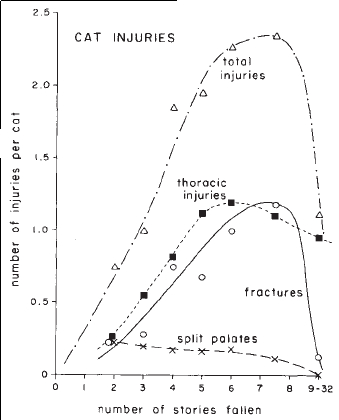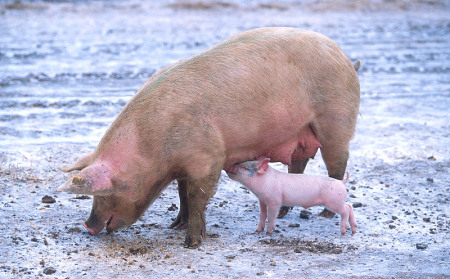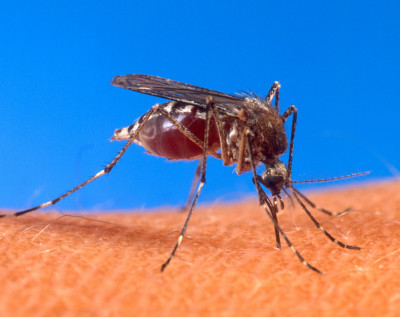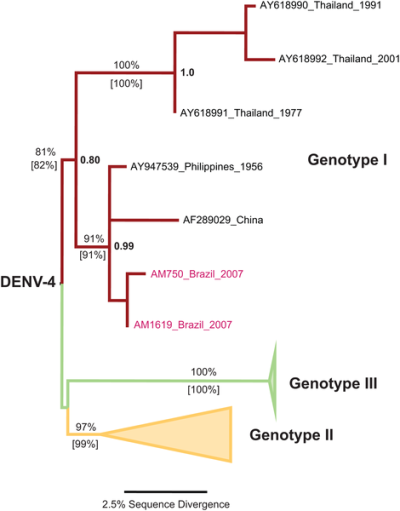The miracle of the falling cat
A cat fell from the 26th floor in New York. What happened to the kitten? Nothing.

The name of the cat is Lucky. Of course, with a name like that, it was no surprise that a miracle saved him. According to the owner:
“That’s the thing about Lucky Miraculous,” HOSTETLER told “GMA.” “He has been [lucky] since we got him.” Source
NOT!
If the cat was really lucky, would it fall from the window? Does every miracle requires something bad happening before?
Actually, the cat would be more lucky if he had dropped the 7th floor and survived. Why?
 Based on the records of cat falls, the rule “the higher, the worse” is not true. Moreover, a cat survived a 32 floors fall in the concrete, something like 450 feet, and only spent two days of observation and got a chipped tooth. Here is the figure everyone wants to see:
Based on the records of cat falls, the rule “the higher, the worse” is not true. Moreover, a cat survived a 32 floors fall in the concrete, something like 450 feet, and only spent two days of observation and got a chipped tooth. Here is the figure everyone wants to see:

Source: Nature.
DISCLAIMER, nobody was throwing kittens out the window to calculate
the damage, these number are simply records of veterinary care
emergencies.
The majority of cats (90%) in this study survived (omitting the ones euthanatized by owners unable to afford treatment). The most common traumas of those who died were shock and thoracic injuries. The figure above shows that the frequency of injuries increase with the height but, instead of continuing and stabilizing at 100%, as would have happened if we were talking about people, it starts to fall! Cats suffer worst fates when they fall between the sixth and eighth floor.
Not all animals need to be afraid of gravity! Indeed, the vast majority of them, in number and diversity, do not. The damage suffered by cats that fall from different heights depends on two factors: the force that results from the animal’s mass and acceleration (gravity) F = Mxa and the area where the force is distributed F/A. Here lies the difference.
The larger the animal, the heavier it is, but the area it occupies does not increase proportionately. The size determines the weight of the animal, so the force it exerts when it falls increases in three dimensions, cubic. But the surface of the animal increases in two dimensions, a square relation. The greater the surface/volume ratio, the more air resistance the animal does and smaller is the final speed during his fall. Just think of a aluminum sheet dropping open or mashed.This means that ants, beetles, spiders and mice also do not need to worry about the height they fall. A fall of 1 foot or 20 thousand feet does not matter for them, since the final speed in fall is low and they distribute the impact in a relatively larger area. Meanwhile, any little fall for an elephant is dangerous.
When a cat falls, its terminal velocity (maximum speed in the fall) is about 60 mph, and the impact is distributed among the 4 limbs because the effective gyroscope that allows cats to turn during the fall and land almost always on feet, the vestibular system – hence the difference between a cat and a dog falling. Humans reach a terminal velocity of 120 mph and usually land on their head or legs, which means a more lethal fall, with more internal bleeding and head injuries.
When cats begin to fall, they stretch the limbs and increase their tension. When the height is greater, as in the case of higher floors, the cat has enough time to relax and let their limbs stay horizontally, increasing its surface, reducing the terminal velocity and distributing better the impact. By flexing the legs, they absorb the impact, as a spring. One of the most common injuries in cat drops is broken jaw, because the body relax as a whole and lets the jaw hit the floor.
Through their climbers history, the evolution of cats explains their nine lives. They need no miracle for that.
Diamond, J. (1988). Why cats have nine lives Nature, 332 (6165), 586-587 DOI: 10.1038/332586a0
========================
This post was translated by Atila from the original published at the Brazilian blog Rainha Vermelha.
What you need to know about swine fever
This is a translated version of this post, written originally in Portuguese by Atila Iamarino at Rainha Vermelha.
What is swine fever, and why may it be so dangerous? Response in 8 steps:
1 – What is the flu virus, and what means H1N1:
2 – What is the danger of a different virus?
3 – Why is swine flu dangerous?
4 – What is the risk of a pandemic?
5 – Do we have defenses against the virus?
6 – Individual attitudes that can help.

1 – What is the flu virus, and what means H1N1:
The flu is caused by a virus called influenza. There are 3 types of influenza: A, B and C. The influenza A is more variable and infects more people every year. It has 8 pieces of RNA (yes, RNA, not DNA) within its capsule. Two of its proteins are very important to understand: one is called Hemagglutinin, which is outside the virus and makes contact with the cell. Hemagglutinin has this name because when we put the virus in a drop of blood, red blood cells are agglutinated (hemo agglutinins, hemagglutinin). The other is Neuraminidase, which breaks the sugar to which hemagglutinin binds, in order to free the newly formed viruses.
Both hemagglutinin and neuraminidase are pointed outside of the virus, in consequence, these proteins are usually recognized by antibodies and used in diagnostic tests. That is why the strains of influenza are named by the letters HN, like H1N1, H3N2, according to the types of proteins.
There are 16 known types of hemagglutinin and 9 neuraminidase. Only a few are common in humans: H1, H2 and H3 and N1 and N2. All the other types are found in waterfowl, particularly ducks, that are the natural reservoir of influenza A. Migratory birds mix the virus across the world. They do not have flu symptoms and influenza infects their digestive system rather than the respiratory tract. When they stop to feed in water bodies during the migration and defecate in water, they spread the influenza. The virus may last up to 30 days in cold waters like in a lake. The most dangerous types, which kill many chickens and people when transmitted, are H5 and H7. [1]

Influenza virus electron microscopy.
2 – What is the danger of a different virus?
We lack immunity to influenza A because this virus mutates too fast [2]. Two phenomena are important: the drift, in which the virus accumulates small changes in H and N genes that, after some time, make them unrecognizable to our immune system. More importantly, and more often than thought, is the shift. The shift happens when two different influenza enter the same cell mix their genetic material, and some of the eight RNA strands comes from virus x and others comes from virus y. When this happens, the virus changes abruptly, and our immune system is completely unprepared. This is the biggest reason of vaccines fail. As there is a delay between collecting the virus and producing the vaccine, every year we have to study the virus and try to predict which group will be the most important in the epidemic.
The largest oh the recent influenza epidemics occurred when the virus rearranged between human and avian viruses, such as the 1957 Asian flu (H2N2) and Hong Kong 1968 (H3N2). The Spanish flu virus, H1N1, apparently jumped directly from ducks to humans, without any rearrangement [3]. What does intermediate the rearrangements, between human and avian viruses? Pigs and chickens.
That is why most of the influenza pandemic starts in Asia. You can easily picture popular markets crowded with people, where ducks, wild ducks, chickens, geese and pigs are sold. Another factor is how pigs are fed: they put the cage of the ducks and chickens on top of the cage of the pigs and provide food only for birds. This creates ideal conditions for the emergence of avian viruses infecting humans.
3 – Why is swine fever dangerous?
The most common virus in pigs is the H1N1. The virus that infected people in Mexico and California was sequenced by a Canadian team. It seems to be a reassortment between two pig strains: one that circulates in America and other that circulates in Europe. None of these strains is known to infect humans so there is probably little immunity to this virus in population. None of the genes come from H5N1, which caused the bird flu, or human strains.
Another worrying factor is that the current swine influenza virus has infected mostly young people. Typically, children and elderly people suffering from flu. The pattern of aggressive virus that attacks young people with the strong immune system and healthy, is a remarkable characteristic of Spanish Flu of 1918. This does not seems to be the case of swine fever, and we don’t know all the cases to see the death rate between youth.
4 – What is the risk of a pandemic?
This is not the first outbreak of Swine Flu. The largest outbreak occurred in Fort Dix, an American military camp in 1976 and taught a great lesson for the health authorities. At that time, it was expected to be a large influenza outbreak, and everything indicated that the swine flu virus was attacking the young soldiers. The pressure generated from 500 sick people and one death made wrong decisions to be taken, and there was a mass vaccination in the U.S. with drastic consequences. I recommend reading the book The incoming Plague, by Laurie Garrett, who explains this in details.
The point is that WHO, the main responsible for monitoring flu outbreaks around the world, does not work with “if we have an influenza pandemic”, but “when we will have”. With population size we have reached, and the ease of transportation we have today, it is very likely that a dangerous strain of influenza would cause great damage. Be the pandemic caused by avian influenza virus, swine or any other.
Here is a not so exciting part of the 10 items list on pandemic influenza from WHO:
“We are on the verge of an outbreak. All countries will be affected. The medical supplies will be inadequate. Many deaths will occur. The economic and social disruption will be enormous.”
The WHO has a world wide warning that goes from 1 to 6, 1 means all quiet, no dangerous disease and at 6 things get a little complicated, the pandemic is running loose. We are in stage 5, there is a disease being transmitted person to person in more than oneWHO region.
5 – Do we have defenses against the virus?
There are only a few antiviral drugs because, unlike bacteria, the virus uses the host cells to reproduce, leaving justa few possible targets. In the case of influenza, there are the neuraminidase inhibitors, such as Tamiflu and Amantadine, which prevent the virus to release the cell. The high mutation rate of the virus allows it to easily develop resistance to drugs, and do not know what will happen to H1N1.
The current strain is resistant to amantadine and rimantadine, but susceptible to Tamiflu.
Another defense against the flu is the vaccine. They are the most inexpensive and effective protection against the flu. The issue is the agility to develop a vaccine for the virus and distribute to population in time. And there is an order of priorities for vaccination. Key people at first, like government officials, doctors, then more susceptible people, such as elderly and children, and finally the population as a whole.
6 – Anyway, there are individual attitudes that may help:
Wash your hands thoroughly and frequently. Contrary to what we imagine, it is easier to contract the influenza with a handshake than a kiss on the face. If someone cold covers the sneezes with the hand and you handshake this person, you can put your hand in contact with eye and nose, and contract the virus. So, wash hands thoroughly and regularly, and if you get flu, cover your sneeze with a tissue and throw away.
Avoid crowds and enclosed spaces, mainly with air-conditioning. The Influenza lasts longer in the dry and cold, and a room with an air-conditioned mixes several people in conditions for the virus. [4] But remember, DON’T PANIC!
Recommended reads:
The Coming Plague: Newly Emerging Diseases in a World Out of Balance by Laurie Garret. A very throrough book that includes the 1918 spanish flu, the 1976 swine flu and some perspectives for the future.
Potter, C.W. “A history of influenza.” Journal of Applied Microbiology 91, no. 4 (2001): 572-579. DOI: /10.1111/j.1365-2672.2001.01492.x.
References (besides the links in the post):
[1] Webster, R G, W J Bean, O T Gorman, T M Chambers, e Y Kawaoka. “Evolution and ecology of influenza A viruses.” Microbiological Reviews 56, no. 1 (Março 1992): 152-179.
[2] Drake, J W. “Rates of spontaneous mutation among RNA viruses.” Proceedings of the National Academy of Sciences of the United States of America 90, no. 9 (Maio 1, 1993): 4171-4175.
[3] Reid, Ann H., Thomas G. Fanning,
Johan V. Hultin, e Jeffery K. Taubenberger. “Origin and evolution of
the 1918 “Spanish” influenza virus hemagglutinin gene.” Proceedings of the National Academy of Sciences of the United States of America 96, no. 4 (Fevereiro 16, 1999): 1651-1656.
[4] Lowen, Anice C, Samira Mubareka,
John Steel, e Peter Palese. “Influenza Virus Transmission Is Dependent
on Relative Humidity and Temperature.” PLoS Pathog 3, no. 10 (Outubro 19, 2007): e151.
How governments should (not) deal with epidemics
 Brazilian government has been really concerned about swine flu. We have health agents in airports and ports to detect possible flu cases. But let’s see how it deals with Dengue, another infectious disease with a well-known life cycle, efficient prevention strategies and distinguishable symptoms.
Brazilian government has been really concerned about swine flu. We have health agents in airports and ports to detect possible flu cases. But let’s see how it deals with Dengue, another infectious disease with a well-known life cycle, efficient prevention strategies and distinguishable symptoms.

Dengue is a serious issue in Americas, with more than 850,000 cases only in 2008. Until 2007, Brazil had detected the Dengue´s serotypes 1, 2 and 3. In April, 2008 researchers found at Manaus, the largest city in Brazilian Amazon forest, Dengue virus type 4 in three patients with no history of traveling outside the city. This was a matter of great concern because serotype 4 has a low prevalence but is involved with a bigger occurrence of dengue hemorrhagic fever. [1]
However, instead of taking action, Brazilian Health Ministry made a public announcement denying that serotype 4 occurs in Brazil and has accused the laboratory of contamination, despite the fact that this laboratory does not maintain any dengue 4 virus in culture. Later, a EID publication about Amazon endemic diseases that has a Health Ministry worker (R. Glatt) as one of the authors, claimed, with no supporting reference, that:
“In September 2008, data on the isolation of DEN-4 in the Amazon region
were revised and now show that there is no evidence that this serotype
circulates in the Amazon region of Brazil.“
In April this year, some of my lab colleagues reanalyzed the dengue virus sequences with a more phylogenetic approach as the authors of the previous publication had typed the virus using BLAST, which is not the best tool to find the closest relatives of the virus.[2]
Not surprisingly, not only the results were confirmed but things got a little more interesting: they found that Dengue 4 of the genotype II (there are 3 genotypes: I, II and III) have been in America for at least 20 years as it was found in Brazil in 1982. However, the closest relative to the serotypes isolated in Manaus is the genotype I, that circulates only in Asia.

Dengue 4 phylogenetic tree with Manaus sequences in pink. Source: [2]
In conclusion, not only do we have Dengue 4 circulating in Brazil, in low frequencies (yet), but it also came from Asia! This could become a great problem to the country if the right measures are not taken.
In the year that Brazil government denied dengue 4, more than 700,000 people were infected by dengue. Up to March 2009, there have been 126,139 suspect cases, including several epidemics in a few cities in Bahia State like Jequié, where at least 5% of the population having contracted the virus.
In conclusion, instead of paying attention at science funded by itself (virtually all research done in Brazil is financed by public money), the Brazilian Health Ministry
has opted to have corporativist attitude and simply denied the
discovery. The results of this attitude are, unfortunately, human lives as we already had 23 confirmed deaths in 2009.
[1] Figueiredo, Regina Maria Pinto de, Felipe Gomes Naveca, Michele de Souza Bastos, Miriam do Nascimento Melo, Suziane de Souza Viana, Maria Paula Gomes Mourão, Cristóvão Alves Costa, e Izeni Pires Farias. “Dengue Virus Type 4, Manaus, Brazil.” Emerging Infectious Diseases 14, no. 4 (Abril 2008): 667-669.
[2] de Melo, F., Romano, C., & Zanotto, P. (2009). Introduction of Dengue Virus 4 (DENV-4) Genotype I into Brazil from Asia? PLoS Neglected Tropical Diseases, 3 (4) DOI: 10.1371/journal.pntd.0000390
—
This is a post written by Atila at Rainha Vermelha. Revised by Carlos Hotta.






